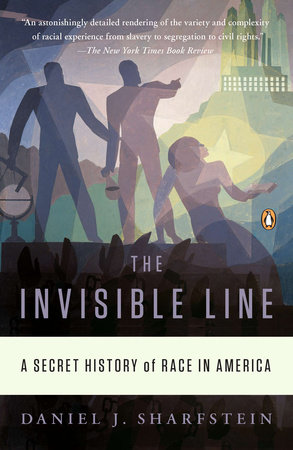The Invisible Line: Three American Families and the Secret Journey from Black to White |
The Invisible Line: Three American Families and the Secret Journey from Black to White
The Penguin Press
2011-02-17
416 pages
6.14 x 9.25in
Hardcover ISBN: 9781594202827
Daniel J. Sharfstein, Professor of Law
Vanderbilt University, Nashville, Tennessee
Winner of the 2012 J. Anthony Lukas Book Prize
In America, race is a riddle. The stories we tell about our past have calcified into the fiction that we are neatly divided into black or white. It is only with the widespread availability of DNA testing and the boom in genealogical research that the frequency with which individuals and entire families crossed the color line has become clear.
In this sweeping history, Daniel J. Sharfstein unravels the stories of three families who represent the complexity of race in America and force us to rethink our basic assumptions about who we are. The Gibsons were wealthy landowners in the South Carolina backcountry who became white in the 1760s, ascending to the heights of the Southern elite and ultimately to the U.S. Senate. The Spencers were hardscrabble farmers in the hills of Eastern Kentucky, joining an isolated Appalachian community in the 1840s and for the better part of a century hovering on the line between white and black. The Walls were fixtures of the rising black middle class in post-Civil War Washington, D.C., only to give up everything they had fought for to become white at the dawn of the twentieth century. Together, their interwoven and intersecting stories uncover a forgotten America in which the rules of race were something to be believed but not necessarily obeyed.
Defining their identities first as people of color and later as whites, these families provide a lens for understanding how people thought about and experienced race and how these ideas and experiences evolved-how the very meaning of black and white changed-over time. Cutting through centuries of myth, amnesia, and poisonous racial politics, The Invisible Line will change the way we talk about race, racism, and civil rights.
Three American families’ stories…
The Gibsons
The Gibsons were among the first free people of color in seventeenth-century Virginia, most of whom were free because their mothers were English and by law slavery followed the status of the mother. In the early l700s, as Virginia’s laws made it increasingly difficult for free blacks to own property and earn a living, the Gibsons left the colony for the southern frontier. When the Gibsons reached South Carolina in the 1730s, the colonial assembly worried.that they had come to organize a slave revolt. But after personally interviewing the family, the colonial governor granted them hundreds of acres of land in a Welsh and Scots-Irish community. After one generation they were neither black nor white-they were planters. In the nineteenth century, they rose to the heights of the Southern aristocracy. They sent their sons to Yale and had vast holdings of land and slaves near Vicksburg, Mississippi, Lexington, Kentucky, and Terrebonne Parish, Louisiana. Gibsons were rebel officers, powerful opponents of Reconstruction, and leaders of the New South.’ One became a United States Senator from Louisiana.
The Spencers
The Spencers’ story begins in the Appalachian Mountains. In an area that had more slaves and more free blacks than anywhere else in eastern Kentucky-largely because of a bustling salt mining industry there in the early 1800s-two free men of color began having children with a pair of white sisters who had recently moved from South Carolina. Shortly before one man, George Freeman, was prosecuted for interracial sex, the other man, Jordan Spencer-possibly Freeman’s brother or son-moved with his family one hundred miles deeper into the mountains. Even though he was visibly dark-skinned, his new community in Johnson County, Kentucky, decided that he could be white. His family hovered on the line between black and white for the rest of the century, farming and logging in a mountain hollow before heading into the coal mines.
The Walls
The Walls trace their roots to a wealthy plantation owner in Rockingham, North Carolina. Stephen Wall never married, but he had children with three of his slaves, In the 1830s and 1 840s, he freed his children and sent them to Ohio to be raised by radical Quaker abolitionists. He bought land for them, generously supported their education at places like Oberlin College, and willed them a lot of money. No one knows why. He kept their mothers in bondage. The children became ardent abolitionists and served in the Union Army and Freedmen’s Bureau. After the War, several moved to Washington, D.C., where they fought for civil rights and women’s rights and raised their families to expect nothing less than equality. But as Reconstruction gave way to Jim Crow, their children disappeared into the white world.
